INSTITUT SUPERIEUR D'ANTHROPOLOGIE
INSTITUTE OF ANTHROPOLOGY
ONLINE COURSES / COURS A DISTANCE
SUMMER TERM : JULY 2014
REGISTER NOW
USA –  Fort Laurens - Fort Laurens State Memorial was buzzing with activity Friday in preparation for an archaeological dig at the northeast bastion of the Revolutionary War-era fort that will take place in July. Just north of the museum, Jarrod Burks of Ohio Valley Archaeology was using surveying equipment to plot where the excavating blocks for the dig will be. While areas inside the fort have been excavated in the past, this portion of the ditch has never been touched by archaeologists before. Soldiers stationed at the fort during the late 1770s lived inside the walls, but Burks said some of the day-to-day items they used may have ended up in the ditch. “We’re hoping they were really messy,” he said. Archaeologists could potentially find kitchen refuse, such as animal bones, parts of uniforms and artifacts related to weapons.
Fort Laurens - Fort Laurens State Memorial was buzzing with activity Friday in preparation for an archaeological dig at the northeast bastion of the Revolutionary War-era fort that will take place in July. Just north of the museum, Jarrod Burks of Ohio Valley Archaeology was using surveying equipment to plot where the excavating blocks for the dig will be. While areas inside the fort have been excavated in the past, this portion of the ditch has never been touched by archaeologists before. Soldiers stationed at the fort during the late 1770s lived inside the walls, but Burks said some of the day-to-day items they used may have ended up in the ditch. “We’re hoping they were really messy,” he said. Archaeologists could potentially find kitchen refuse, such as animal bones, parts of uniforms and artifacts related to weapons.
http://www.timesreporter.com/article/20140620/NEWS/140629902/10675/NEWS
IRLANDE – 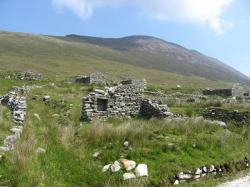 Achill Island - AIA is working with the Achill Project and the Achill Archaeological Field School (AAFS) in Ireland on a new Interactive Dig. The Achill Project is developing a detailed understanding of the archaeology and history of the Slievemore, the largest mountain on Achill Island. The 2014 excavations will focus on the Cromlech Tumulus, a circular structure at the western end of the site. Follow the project as it unfolds.:
Achill Island - AIA is working with the Achill Project and the Achill Archaeological Field School (AAFS) in Ireland on a new Interactive Dig. The Achill Project is developing a detailed understanding of the archaeology and history of the Slievemore, the largest mountain on Achill Island. The 2014 excavations will focus on the Cromlech Tumulus, a circular structure at the western end of the site. Follow the project as it unfolds.:
http://www.archaeological.org/interactivedigs/achillislandireland
ROYAUME UNI – 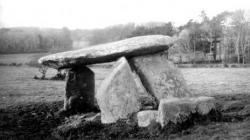
 Carwynnen Quoit - Work to rebuild a collapsed ancient Cornish monument has been completed on the day of the summer solstice. Carwynnen Quoit, or Giant's Quoit, a 5,000-year-old burial chamber near Troon, collapsed in 1966. The burial chamber had fallen apart but, with help from archaeologists, it is standing proud once again.The ancient granite monument is believed to date as far back as the Neolithic period. The Cornwall Sustainable Trust and Cornwall Heritage Trust employed professional archaeologists to help research and rebuild it. Initial work saw two support stones replaced in their original Neolithic footings but the third stone had to be adjusted to comply with health and safety regulations. The main capstone measuring 3.3m (11ft) long, 2.5m (8ft) wide and 30cm (1ft) thick was dropped into position by a large crane.
Carwynnen Quoit - Work to rebuild a collapsed ancient Cornish monument has been completed on the day of the summer solstice. Carwynnen Quoit, or Giant's Quoit, a 5,000-year-old burial chamber near Troon, collapsed in 1966. The burial chamber had fallen apart but, with help from archaeologists, it is standing proud once again.The ancient granite monument is believed to date as far back as the Neolithic period. The Cornwall Sustainable Trust and Cornwall Heritage Trust employed professional archaeologists to help research and rebuild it. Initial work saw two support stones replaced in their original Neolithic footings but the third stone had to be adjusted to comply with health and safety regulations. The main capstone measuring 3.3m (11ft) long, 2.5m (8ft) wide and 30cm (1ft) thick was dropped into position by a large crane.
http://www.bbc.com/news/uk-england-cornwall-27945128?
FRANCE -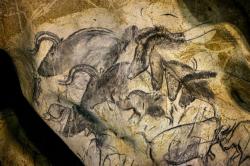 Chauvet - UN cultural agency UNESCO on Sunday granted its prized World Heritage status to a prehistoric cave in southern France containing the earliest known figurative drawings. Delegates at UNESCO's World Heritage Committee voted to grant the status to the Grotte Chauvet at a gathering in Doha, where they are considering cultural and natural wonders for inclusion on the UN list. The cave in the Ardeche region, which survived sealed off for millennia before its discovery in 1994, contains more than 1,000 drawings dating back some 36,000 years to what is believed to be the first human culture in Europe.
Chauvet - UN cultural agency UNESCO on Sunday granted its prized World Heritage status to a prehistoric cave in southern France containing the earliest known figurative drawings. Delegates at UNESCO's World Heritage Committee voted to grant the status to the Grotte Chauvet at a gathering in Doha, where they are considering cultural and natural wonders for inclusion on the UN list. The cave in the Ardeche region, which survived sealed off for millennia before its discovery in 1994, contains more than 1,000 drawings dating back some 36,000 years to what is believed to be the first human culture in Europe.
http://www.hurriyetdailynews.com/french-cave-home-to-earliest-drawings-wins-world-heritage-status.aspx?pageID=238&nID=68136&NewsCatID=375
TURQUIE – 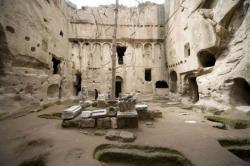 Ilhara - During an archaeological excavation, the relic of the nun, which dates back to the Byzantine era about 1,100 years ago, was discovered. It was found in the valley of Ilhara, an area where a Greek Orthodox community use to live in cave monasteries, consisting of both monks and nuns. Examinations on the relic have determined that the body belongs to a young woman of about 22-year old who was a nun at the area. Although many centuries have passed by since her death, she was preserved in a good condition. Because of her looks, the Turks gave her the name ‘The Blonde Nun’. It is also believed that her corpse was intact, because she was sacred. The museum in Nigde, which houses her relic, has become very popular lately, as many Turks arrive to see and admire ‘The Blonde Nun’.
Ilhara - During an archaeological excavation, the relic of the nun, which dates back to the Byzantine era about 1,100 years ago, was discovered. It was found in the valley of Ilhara, an area where a Greek Orthodox community use to live in cave monasteries, consisting of both monks and nuns. Examinations on the relic have determined that the body belongs to a young woman of about 22-year old who was a nun at the area. Although many centuries have passed by since her death, she was preserved in a good condition. Because of her looks, the Turks gave her the name ‘The Blonde Nun’. It is also believed that her corpse was intact, because she was sacred. The museum in Nigde, which houses her relic, has become very popular lately, as many Turks arrive to see and admire ‘The Blonde Nun’.
http://eu.greekreporter.com/2014/06/22/the-relic-of-a-1100-year-old-orthodox-nun-discovered-in-turkey/?
INDE –  Patan - Rani ki Vav (queen’s stepwell), in Gujarat’s Patan town, has been added to Unesco’s list of World Heritage sites, an official statement said Sunday. “Rani ki Vav has been approved for inscription on the World Heritage list,” said a statement of the ministry of culture, adding that the decision was taken by Unesco at the World Heritage Committee session currently on at Doha, Qatar. “Unesco has recognised this masterpiece as an exceptional example of technological development in utilising groundwater resources in a single component, water management system and it illustrates the exceptional capacity to break large spaces into smaller volumes following ideal aesthetic proportions,” it added. “The ancient stepwell was built in the 11th century and is an example of a unique Indian subterranean architectural structure. Its seven storeys of ornamented panels of sculptures and relief represent the height of the Maru-Gurjara style,” said the statement. “Following the flooding and disappearance of the Saraswati river due to geotectonic changes, the property was buried under layers of silt for almost seven centuries and has been preserved underneath in an exceptional state of conservation by the Archaeological Survey of India (ASI),” the statement added.
Patan - Rani ki Vav (queen’s stepwell), in Gujarat’s Patan town, has been added to Unesco’s list of World Heritage sites, an official statement said Sunday. “Rani ki Vav has been approved for inscription on the World Heritage list,” said a statement of the ministry of culture, adding that the decision was taken by Unesco at the World Heritage Committee session currently on at Doha, Qatar. “Unesco has recognised this masterpiece as an exceptional example of technological development in utilising groundwater resources in a single component, water management system and it illustrates the exceptional capacity to break large spaces into smaller volumes following ideal aesthetic proportions,” it added. “The ancient stepwell was built in the 11th century and is an example of a unique Indian subterranean architectural structure. Its seven storeys of ornamented panels of sculptures and relief represent the height of the Maru-Gurjara style,” said the statement. “Following the flooding and disappearance of the Saraswati river due to geotectonic changes, the property was buried under layers of silt for almost seven centuries and has been preserved underneath in an exceptional state of conservation by the Archaeological Survey of India (ASI),” the statement added.
http://gulfnews.com/news/world/india/gujarat-s-rani-ki-vav-now-unesco-world-heritage-site-1.1350731?
IRAQ -  – Ur - An enigmatic box from a bygone era, filled with pottery, seeds and animal bones, has been discovered in the University of Bristol's Department of Archaeology and Anthropology. The box was found while researchers were emptying current laboratory spaces in preparation for the installation of a new state-of-the-art radiocarbon dating facility. Index cards nestled amongst the objects in the box provided a clue to the origins of the material. Key words such as ‘Predynastic’, ‘Sargonid’, and ‘Royal Tombs’ suggested the remains came from the famous excavations by Sir Leonard Woolley in southern Iraq at the site of Ur during the 1920s and early 1930s. The discovery is very exciting because environmental finds were rarely collected in this early period of archaeological fieldwork, especially from this part of the world. Further investigation revealed that these were the remains of food offerings from a royal tomb at least 4,500 years old.
– Ur - An enigmatic box from a bygone era, filled with pottery, seeds and animal bones, has been discovered in the University of Bristol's Department of Archaeology and Anthropology. The box was found while researchers were emptying current laboratory spaces in preparation for the installation of a new state-of-the-art radiocarbon dating facility. Index cards nestled amongst the objects in the box provided a clue to the origins of the material. Key words such as ‘Predynastic’, ‘Sargonid’, and ‘Royal Tombs’ suggested the remains came from the famous excavations by Sir Leonard Woolley in southern Iraq at the site of Ur during the 1920s and early 1930s. The discovery is very exciting because environmental finds were rarely collected in this early period of archaeological fieldwork, especially from this part of the world. Further investigation revealed that these were the remains of food offerings from a royal tomb at least 4,500 years old.
http://bristol.ac.uk/news/2014/june/box-of-mystery.html
ROYAUME UNI – 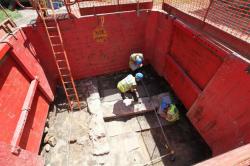 Newcastle - A dig has already uncovered medieval remains in what was a bustling area of the town. It is known that the site was fully developed in the mid and late 19th Century, while an indoor market stood on the site in the modern era. But there has been a gap in the Quayside frontage since the building which housed a market was demolished some years ago.The plot lies within the medieval town walls of Newcastle, in an area which was reclaimed from the River Tyne by 1400. The original north bank of the Tyne lay approximately 60m north of the site below Dog Bank and All Saints Church. The river now lies 25m further south of the site’s street frontage. As revealed by previous digs in the area, land on the edge of the Tyne west of Lort Burn was gradually reclaimed from the river during the 13th-14th Centuries with a series of piers and stone and wicker revetments and terraces, supported on dumps of waste material several metres deep. As the land was reclaimed, a thick sequence of ballast deposits from ships raised the land higher than the river to allow development. This process has been further confirmed by the discovery on the site of man-made structures and deposits which had been added to create successive new river frontages pushing the river back. With the land won from the river, Newcastle’s Town Wall had been built along the Quayside by 1400.To the rear of the plot, they have uncovered a substantial north-south sandstone medieval wall which may have been a property boundary or a pier constructed as the land was being reclaimed. Excavation is currently underway of medieval industrial waste deposits to the west of the wall and land reclamation deposits to the east. Pottery from the late 14th to early 15th Century has been recovered, much of it with a distinctive green glaze, typical of the period, created by adding copper to a basic lead glaze.
Newcastle - A dig has already uncovered medieval remains in what was a bustling area of the town. It is known that the site was fully developed in the mid and late 19th Century, while an indoor market stood on the site in the modern era. But there has been a gap in the Quayside frontage since the building which housed a market was demolished some years ago.The plot lies within the medieval town walls of Newcastle, in an area which was reclaimed from the River Tyne by 1400. The original north bank of the Tyne lay approximately 60m north of the site below Dog Bank and All Saints Church. The river now lies 25m further south of the site’s street frontage. As revealed by previous digs in the area, land on the edge of the Tyne west of Lort Burn was gradually reclaimed from the river during the 13th-14th Centuries with a series of piers and stone and wicker revetments and terraces, supported on dumps of waste material several metres deep. As the land was reclaimed, a thick sequence of ballast deposits from ships raised the land higher than the river to allow development. This process has been further confirmed by the discovery on the site of man-made structures and deposits which had been added to create successive new river frontages pushing the river back. With the land won from the river, Newcastle’s Town Wall had been built along the Quayside by 1400.To the rear of the plot, they have uncovered a substantial north-south sandstone medieval wall which may have been a property boundary or a pier constructed as the land was being reclaimed. Excavation is currently underway of medieval industrial waste deposits to the west of the wall and land reclamation deposits to the east. Pottery from the late 14th to early 15th Century has been recovered, much of it with a distinctive green glaze, typical of the period, created by adding copper to a basic lead glaze.
http://www.thejournal.co.uk/news/north-east-news/archaeology-dig-starts-newcastle-quayside-7303186